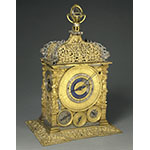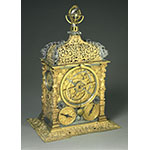This table clock has a richly decorated pavilion-shaped case, with a fretworked dome surmounted by an armillary sphere. Each side of the clock carries dials with different functions, operated by gear mechanisms inside the case. Of the two larger dials, one is of the planispheric astrolabe type, with an external hour circle numbered from I to XII twice and a reversible tympanum for locating star positions and determining the planetary hours. It is preset for latitude 48° on one side and latitude 40° on the other. Above this dial, a pendulum was hooked on at a later date (17th C.). The other larger dial, also reversible, displays months, dates, major saints' days, the seasonally changing duration of light and darkness from dawn to sunset, and some hour computations. The armillary sphere, with the Earth placed at the center and a small magnetic compass in the base, is operated manually. The chime for the hours, quarter-hours, and minutes is under the dome. The alarm mechanism is missing. The iron movement has three trains driven by springs inside barrels with a fusee: one train is for timekeeping, one for the hours chime, and one for the minutes chime.
The back of the astrolabe dial is stamped twice with the initials CR joined inside a shield: the letters may stand for Caspar Rauber. The original leather case is lined on the inside and outside with red velvet. There are six openings protected by crystals. The globe-shaped top, also covered in leather, protects the armillary sphere. The case is divided into three parts: the base, with a drawer for the keys, and two façade covers.
Possibly the clock made in Florence for Maria Cristina of Lorraine, wife of Grand Duke Ferdinand I de' Medici. Remained in the possession of the Medici and was later exhibited in the Tribuna di Galileo. Restored to working order in 1878.











